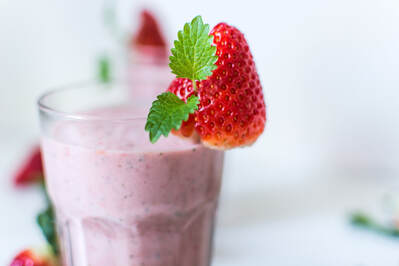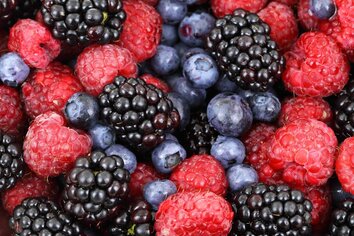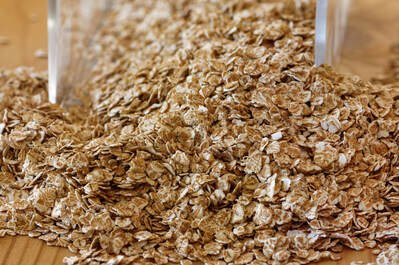What Happens When We Turn Our Fruits and Vegetables into Drinks? - Part 3 - Things to Consider29/1/2019  Fibre was discussed in part one, and micro and phytonutrients in part two. This is the final part talking about some extra considerations when turning our produce into drinks. Considerations Drinking your food can be easier than eating your food. What I mean by that is most people could consume more food in liquid form than in solid form (Flood-Obbagy et al 2009). Therefore making a smoothie can be a super easy way to get some fruits and veggies in if you struggle to eat them or meet your 5+ a day. This could also be beneficial to those who are just struggling to eat enough in general. For example, some athletes with a heavy training schedule may struggle to get enough from eating food alone, so for them a smoothie could be one way to pack in some much need nutrients. Now because we can consume more by drinking our food we also run the risk of over consuming. For example, I could take my usual breakfast of oats, milk, peanut butter, and a banana, put it in a blender but with more of each ingredient plus other things and gulp it down. I’ve just eaten a lot more than I normally would for breakfast when I potentially didn’t need it, and may even still be hungry afterward. Doing this repeatedly could then lead to unwanted weight gain because I am now technically eating more. My recommendation here would be to ask yourself before making your drink, “Would I normally eat what I’m about to put in the blender?” If you are someone struggling to eat enough then still be mindful of what exactly you’re putting in your drink. Also, ask the question, "Does this satisfy me?", or are you going to go looking for something else to finish off breakfast. Something to note is sipping on your smoothie as opposed to gulping it down may also help make your smoothie a little more satisfying. There is also the train of thought that by blending a bunch of fruits together we create a drink that is acidic and potentially detrimental to health of our teeth (Ali et al 2014). The effect our drink has on our teeth is very dependent on what the ingredients actually are and how often we are sipping away. Drinking with a straw and not sipping on your smoothie over the day could be two easy ways to reduce any effect we may have on our teeth. Summary The whole, unprocessed version of our fruits and vegetables should still be our first choice, but making our produce into drinks is an option to help get our 5+ a day. Different processing methods will affect different produce differently. In general, a smoothie/blended whole produce is closer to its natural state, and probably the healthier option over a juice that's not as filling and lacking fibre. In smoothies, fibre is still retained but its structure and potentially function is altered because of it. We still get a lot of micro and phytonutrients from blended produce but we cannot definitively say doing so will “unlock” all the nutrients “trapped” in our fruits and vegetable, as some appliance manufacturers would claim. I would suggest making your own smoothie so you are aware of the ingredients too. Some drink manufacturers have gone with the notion of “more is best” in terms of ingredients, and there are plenty of commercially available smoothies that contain a lot more than is necessary. Keep in mind the ease of over-consuming while drinking our foods and remember to ask yourself, "Would I normally eat everything I am putting into the blender?" Thanks for reading. Marco
3 Comments
What Happens When We Turn Our Fruits and Vegetables into Drinks? - Part 2 - Micros and Phytos23/1/2019  There is a saying that we aren’t what we eat, but rather we are what we absorb. Therefore following on from the last blog post, this article will investigate what happens to the vitamins, minerals and phytochemicals/nutrients when we turn our produce into drinks. If you haven’t read part one looking at fibre then click here. Micronutrients Micronutrients sometimes referred to as micros include vitamins and minerals that are essential for our survival. They are needed in smaller amounts thus the name micro-nutrients and are important for helping our body produce everything it needs like hormones and enzymes. To read up on micros more click here. Phytochemicals/Phytonutrients Phytochemicals are another group of chemicals that are produced by plants. These chemicals are thought to provide beneficial effects to human health such as antioxidant, anti-inflammatory, and antifungal properties. It should also be noted that some micronutrients also exhibit anti-oxidant effects as well as having other roles in the body like vitamin c and selenium. Some examples of groups of phytochemicals include polyphenols and carotenoids (you don't need to remember that right now). Claims Some manufacturers of blenders, smoothie makers and juicers make claims that their machine will help unlock the trapped nutrients within fruits and vegetables making them more readily absorbed. Some will even claim these turn our ordinary foods into super-foods (sigh). Are These Claims True? We know that food does require breaking down to release certain nutrients. Plants hold different nutrients in different compartments, and so as part of the eating process we need to break these plants down to help our bodies absorb these nutrients. This is normally the job of our mouth (chewing) as well as the mechanical and chemical breakdown in our stomach and GI tract. Looking at the effects of blending there is some research to suggest that putting our produce through this process will make the nutrients found inside more accessible. A study done in 2012 found that the smaller the particle size of the food (i.e the more it had been blended) the more accessible the nutrients investigated were (Katlijin et al 2012). This study, however, used much more extensive processing methods to breakdown their produce than found in the average kitchen. They vacuum packed the produce, then heated them in a water bath followed by soaking them in deionized water. Then some of the produce was taken through high-pressure homogenization. Nobody is doing that with their morning smoothies. What they were left with was a puree made up of different sized particles. Similar to Goldilocks and the three bears they were left with big pieces, medium-sized pieces and tiny little pieces of puree. It was the tiny pieces they were the most accessible but most of the particles were still big pieces and so not as “accessible”. Looking at smoothies vs juices one study made drinks using with whole fruit or juices. It found that for some types of fruit, whole fruit smoothies lead to higher nutrient (vitamin c) content than those made with juice, but for other fruit, it was the opposite (Hee Pyo et al 2014). Now just because the nutrients may now be more accessible, that does not necessarily mean greater absorption. Different nutrients have their own way of being absorbed within our intestine. Some nutrients will compete for absorption with others and so if we have more iron, for example, we may have less calcium absorption. There is also the possibility that once these nutrients are “released” and more accessible they may interact with other things in our blender and form new compounds (Parada et al 2007). This may lead to greater or reduced absorption. Think of it like being in a relationship, and your parents don’t like your partner. You might break up with them making you more “accessible”. You could end up with a new partner your parents like (increased absorption) or one that was worse than the original (decreased absorption). What should also be noted is there are some phytochemicals thought to be bound to the fibre of our fruits and vegetables. Therefore with blending and juicing (which will remove/alter fibre content), there is also potentially the removal of the phytochemicals bound to the fibre (Bravo et al 1994) Summary What we need are well-conducted studies comparing the actual absorption of these nutrients in whole produce vs blended produce vs juiced produced. Unfortunately, we do not have this data. From what it looks like different nutrients and different plants will yield different results under different processing methods. There is no one rule, yet. So in short next time to read that blending your fruits and vegetables is going to help you absorb more of the nutrients found inside them, be skeptical. My interpretation and best advice would be the whole and less processed version should always be your first pick, because we know consumption of these is beneficial to our health and can significantly contribute to our nutrient intake . Look out for the last part of this series talking about some of the other considerations when making these drinks and what their role is in a healthy balanced eating pattern. Thanks for reading. Marco  I can remember not so long ago, and they’re probably still floating around now, seeing ads on TV about the newest juicer or blender which would take your fruits and veggies and “extract vital nutrients from the plants cell wall and turn your produce into a super drink packed with nutrients”. Or something along similar lines. I had also heard as a kid that making smoothies would ruin the fibre from the ingredients and I was best to just eat my fruits and veggies whole. So, does blending destroy fibre? Is it better or worse for absorbing vitamins and minerals? This next series of articles will be unpacking what happens when we take our fruits and veggies and turn them into smoothies and juices. Here is a collection of some of the research and my interpretation. Fibre Fruits and vegetables can be a good source of fibre which is an important component of our diet. Fibre put simply is a type of carbohydrate that cannot be broken down in our gut. This allows it to pass through our small intestine which one, can help to keep us regular and two feeds our gut bacteria. Fibre also has other known benefits such as helping to reduce our cholesterol levels. Fibre is not just one compound/substance, think of it more of a group of different compounds that share the common theme of not being able to be broken down in the human gut. The difference between them is what happens as a result of them staying in our gut. For example, some act as a ‘bulking agent’, bulking up our stool (poop) whereas other types bind with water which can help us pass our stools more easily. There is one train of thought that blending up our produce will destroy the fibre. Is this true? In the case of smoothie making we are not necessarily destroying the fibre but rather altering its composition. This is assuming we are adding whole fruit to our smoothies. When investigated it was found that when fruits where made into smoothies, they retained a significant amount of fibre (Saltaouras et al 2019) whereas juices generally have a much lower fibre content (potentially 10 times less) (Saltaouras et al 2019). Now the fibre that is still available in the smoothie does not necessarily have the same structure and function as whole fruit fibre. It has been shown in oat and wheat fibre, when blended their structure is altered leading to a change in function (Ann-Marie Cadden 1987). In a study looking at oat and wheat fibre the particles were both made smaller, but this resulted in different things for the two types. The wheat fibre had a decreased ability to hold onto water with the opposite occurring in the oat fibre after being blended. Summary In short blending will not completely destroy the fibre per say, but rather alter its structure. Think of putting a log of wood through a wood chipper. You still have the wood but it’s now in a different form and so its function has been altered. We cannot make one generalised comment about what happens exactly to the function though. Blending will affect different fibres differently. There is still some fibre in-tact and so I would hypothesize we should still see some of its benefits like feeding our gut bacteria, but its effect on our bowel habits may be different depending on how it reacts with water. We do not however have conclusive evidence to say exactly what will happen to the fibre and how it will effect us. Look out for the next post next week looking at what happens to the micronutrients followed by phytochemicals/antioxidants of fruits and vegetables when we turn them into drinks. Thanks for reading. Marco |
AuthorWrite something about yourself. No need to be fancy, just an overview. Archives
November 2020
Categories |
